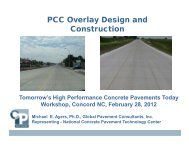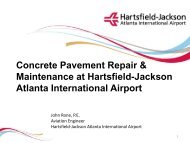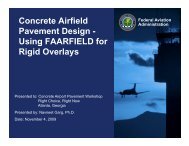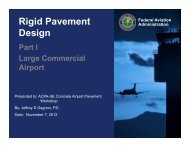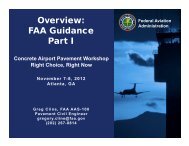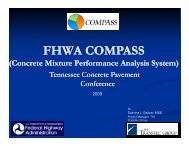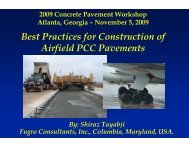South
South
South
Create successful ePaper yourself
Turn your PDF publications into a flip-book with our unique Google optimized e-Paper software.
A Concrete Alternative to Asphalt Reclamation<br />
Berkeley County Airport (MKS)<br />
Moncks Corner, <strong>South</strong> Carolina<br />
October 27, 2011<br />
Matthew P. DuBose, P.E.
Project Team<br />
• Federal Aviation Administration<br />
• <strong>South</strong> Carolina Aeronautics<br />
Commission<br />
• Berkeley County (County Engineering)<br />
• W.K. Dickson & Co., Inc.<br />
Consultant<br />
• APAC-Tennessee<br />
Contractor (Contract #1)<br />
• Sanders Brothers Construction<br />
Contractor (Contract #2)<br />
• Many additional subconsultants and<br />
subcontractors
Airport Location<br />
• Airport located in Moncks Corner, <strong>South</strong> Carolina; <strong>South</strong> Carolina’s Lowcountry<br />
• Lowcountry area known for poor surface/storm drainage, flat grades<br />
Berkeley County Airport
Airport History<br />
• Original pavement data for Runway dated 1967<br />
• Original Runway 3,100’ long and 60’ wide; comprised of asphalt and sand-clay<br />
base<br />
• Extensions, a widening and an overlay have occurred over last four decades<br />
• Current facility consists of a runway that is 4,351’ long and 75’ wide and includes<br />
full parallel taxiway
Project History<br />
• Original CIP identified need for<br />
2” maintenance overlay<br />
• Discussions with Sponsor<br />
identified the desire to embark<br />
on aggressive, multi-stage<br />
Airport expansion<br />
• Ultimate desire was 5,000’ long<br />
x75’ wide runway<br />
• Additional projects include<br />
power line relocation,<br />
obstruction removal, existing<br />
pavement rehab, runway and<br />
taxiway extension and a<br />
drainage improvements project
Project History<br />
• Original design was 2 phases<br />
• Drainage Study, pavement evaluation, then design for both<br />
• Discussions with Sponsor and funding agencies one design project (prelim<br />
and final together)<br />
• Runway Pavement Rehabilitation & Drainage Improvements Project<br />
• 3 Schedules of Work; ability to award independently<br />
• Schedule I – Pavement Rehab / Reconstruction<br />
• Schedule II – Runway Edge Lighting System Replacement<br />
• Schedule III – Airfield Drainage Improvements
Project Process<br />
• 3 Schedules of Work 2 Contract Options<br />
• Schedule I – Pavement Rehab (Contract #1)<br />
• Schedule II – Runway Edge Lighting System Replacement (Contract #1)<br />
• Schedule III – Airfield Drainage Improvements (Contract #2)<br />
• Based on funding available once bids received, award one or both contracts<br />
• Prior to bids, team not optimistic to construct both contracts due to funding<br />
limitations
Runway Pavement Rehab - Design Criteria<br />
• Identify major components needed for<br />
design of new pavement:<br />
• Existing pavement sections and<br />
conditions<br />
• Existing CBR and subgrade<br />
conditions; destructive & non-<br />
destructive ti testing ti performed<br />
• Existing aircraft fleet mix, with eye to<br />
the future<br />
• Additional or extenuating<br />
circumstances (i.e. poor surface and<br />
subsurface drainage)
Runway Pavement Rehab - Design Criteria<br />
• Findings in subsurface investigation reveal three major sections of existing<br />
runway pavements
Runway Pavement Rehab - Design Criteria<br />
• Summary of sections of existing runway:<br />
• Section 1 – (Initial runway 3,100’) – 4.4” Asphalt, 0” Base<br />
• Section 2 – (Ext. #1) – 4.8” Asphalt, 4” Coquina Base<br />
• Section 3 – (Ext. #2) 2” Asphalt, 6” Crushed Aggr. Base<br />
• Based on FAARFIELD analysis, structurally-limiting section was initial runway<br />
construction (Section 1)
Runway Pavement Rehab - Design Criteria<br />
• Based on geotech report, subgrade conditions were very poor<br />
• Wet soils, low strength and stability<br />
• Design CBR = 6 and k-value = 120 pci based on conversations with Geotechnical<br />
Engineer
Runway Pavement Rehab - Design Criteria<br />
• Fleet Mix – developed from information compiled from FAA Form 5010, 2002<br />
Airport Layout Plan (ALP), Sponsor and general knowledge of Airport<br />
No.<br />
Name<br />
Gross Wt.<br />
lbs<br />
Annual<br />
Departures<br />
% Annual<br />
Growth<br />
1 Sngl Whl-5 5,000 18,000 5.00<br />
2 Sngl Whl-12.5 12,500 1,000 5.00<br />
3 Dual Whl-30 30,000 250 3.00<br />
4 Dual Whl-60 65,000 250 2.00<br />
• Ultimate desired design strength for new pavement was for 65,000 pounds, dual-<br />
wheel gear aircraft, per ALP
Runway Pavement Rehab - Design Criteria<br />
• Additional or Extenuating Conditions<br />
• Poor surface and subsurface drainage present<br />
• Use of concrete ditches, underdrains and small stormwater pumping station<br />
to address water-related related issues<br />
• Important to raise elevation of pavement grade, if possible
Runway Pavement Rehab - Design Criteria<br />
• Summary of Design Criteria:<br />
• 3 main sections of pavement, critical area is original Runway<br />
• Poor existing subgrades and CBR/k-values<br />
• Fleet mix based on typical general aviation fleet; most demanding aircraft is<br />
65,000# DWG<br />
• Surface and subsurface drainage issues<br />
• Complete reconstruction not monetarily feasible
Runway Pavement Rehab - Design Criteria<br />
• Based on aforementioned criteria, 2 primary designs for bidding:<br />
• Schedule IA – Cement-Based Full-Depth Asphalt Reclamation<br />
• Schedule IB – Portland Cement Concrete Overlay (Whitetopping)<br />
• All prelim and final designs per FAA Advisory Circular 150/5320-6E and<br />
FAARFIELD design software
Runway Pavement Rehab – Asphalt Reclamation<br />
• Cement application<br />
• Reclaim existing surface<br />
& base course (full-<br />
depth)<br />
• Recompact/re-grade to<br />
serve as new base<br />
• Overlay with asphalt<br />
Photo courtesy of The Barnhardt Group
Runway Pavement Rehab – Asphalt Reclamation<br />
• 4” Asphalt Surface<br />
Course<br />
• Double Chip Seal or<br />
“BST”<br />
• 7” (Min.) Reclaimed<br />
Base; Grade<br />
Correction Required<br />
• Subgrade CBR of 6
Runway Pavement Rehab – Asphalt Reclamation<br />
P-301 Cement Stabilized Reclaimed Base Course 36,260 SY $3.65 $132,349.00<br />
P-301 Portland Cement for Reclaimed Base Course 1,050 TON $110.00 $115,500.00<br />
P-301<br />
Added Coarse Aggregate for Reclaimed Base<br />
Course<br />
1,000 TON $44.85 $44,850.00<br />
P-401 Bituminous Surface Course 9,100 TON $110.00 $1,001,000.00<br />
• Bid with cement as separate item<br />
• Additional coarse aggregate anticipated for lack of base course in areas<br />
• Initial costs of pavement section alone ~ $1.3 million<br />
• Initial costs of all paving-related items ~ $1.48 million
Runway Pavement Rehab – PCC Overlay<br />
• Limiting Section 4.4”<br />
Asphalt, No Base<br />
• Design Flex Strength of<br />
685 psi<br />
• k-value of 120 pci<br />
• Grade Correction<br />
(Milling)<br />
• Sand “Bond-Breaker”
Runway Pavement Rehab – PCC Overlay
Runway Pavement Rehab – PCC Overlay<br />
• Concrete Joint Layout<br />
• Both 25’ &12.5’ wide paving lanes, 12.5’ square panels<br />
• Designed for dowels on<br />
outer lane<br />
• Same amount of dowels<br />
with either layout
Runway Pavement Rehab – PCC Overlay<br />
P-209 Crushed Aggregate Base Course 770 CY $60.70 $46,739.00<br />
P-401 Bituminous Surface Course 920 TON $176.00 $161,920.00<br />
P-501 Portland Cement Concrete Pavement 36,260 SY $32.90 $1,192,954.00<br />
• Crushed aggregate used as<br />
equipment platform<br />
• Asphalt needed d at Taxiway<br />
connections (+9”)<br />
• Initial costs of pavement section<br />
alone ~ $1.2 million<br />
• Initial costs of all paving-related<br />
items ~ $1.56 million
Runway Pavement Rehab – Life Cycle Analysis<br />
• Life Cycle Cost Analysis performed based on 30 years<br />
• Asphalt – 30 year life<br />
• Maintenance on joints/cracks in Years 8 & 23<br />
• 2” Overlay in Year 15<br />
• Present worth cost at end of life ~ $1.72 million<br />
• Concrete – 40 year life<br />
• Maintenance on joints in Years 10 & 20<br />
• Present worth cost at end of life ~ $1.54 million<br />
• “Savings” from salvage value at Year 30, more life anticipated
Runway Pavement Rehab – Life Cycle Analysis<br />
• Asphalt ~ $47.50 / Square Yard<br />
• Concrete ~ $42.51 / Square Yard<br />
• LCCA open to interpretation<br />
• Concrete best option in terms of price, useful life, avoidance of potential ti weather<br />
delays and grade-related drainage issues<br />
• Schedule IB Bid awarded to APAC-Tennessee<br />
• Contracts #1 & #2 awarded<br />
• Total FAA grant amount - $3,583,309
Runway Pavement Rehab – Construction<br />
• Construction commenced November 15, 2010 – big benefit to construct<br />
concrete alternative<br />
• Contractors for Contracts 1 & 2 working simultaneously<br />
• Contractor mobilization & staging area<br />
• Demo of existing pipes and utilities under Runway<br />
• Installation of new drainage structures<br />
• Grade correction on existing pavements<br />
• Underdrain system<br />
• Concrete paving<br />
• Shoulder work and taxiway connectors<br />
• Finalize concrete ditches, pump station and grading
Runway Pavement Rehab – Construction
Runway Pavement Rehab – Construction
Runway Pavement Rehab – Construction
Runway Pavement Rehab – Construction
Runway Pavement Rehab – Construction
Runway Pavement Rehab – Construction
Runway Pavement Rehab – Construction
Runway Pavement Rehab – Construction
Runway Pavement Rehab – Construction<br />
• Concrete Mix<br />
• “Typical” P-501, increase in airentrainment<br />
granted to 3.5%<br />
• 650 psi flex strength<br />
• Delivered in ready-mix trucks,<br />
no batch plant<br />
• Initial i thoughts h were up to 4<br />
trucks delivering at a time,<br />
actual 2-3<br />
• Actual average was ~ 90-100<br />
cubic yards / hour;<br />
• On-site QC trailer & beam<br />
breaks
Runway Pavement Rehab – Construction
Runway Pavement Rehab – Construction
Runway Pavement Rehab – Construction
Runway Pavement Rehab – Construction
Runway Pavement Rehab – Construction
Runway Pavement Rehab – Construction
Runway Pavement Rehab – Construction
Runway Pavement Rehab – Construction
Runway Pavement Rehab – Construction
Runway Pavement Rehab – Construction
Runway Pavement Rehab – Construction
Runway Pavement Rehab – Construction
Runway Pavement Rehab – Construction<br />
• LED Runway Edge Light<br />
• Medium Intensity<br />
• Entire system enclosed<br />
• All cans and conduit, weep holes at<br />
low points
Runway Pavement Rehab – Construction
Summary<br />
• ~ 36,200 square yards of concrete placed on Runway (~9,600 cubic yards)<br />
• Weather days non-issue with concrete compared to reclamation<br />
• Contract time was extended due to two change order issues<br />
• New LED Runway Lights – believed to be first in SC on general aviation<br />
Airport<br />
• New underdrain pump system – believed to be first in SC of its kind<br />
• Concrete a huge success due to monetary feasibility, useful life and grade<br />
issues with Lowcountry site
Questions Comments



